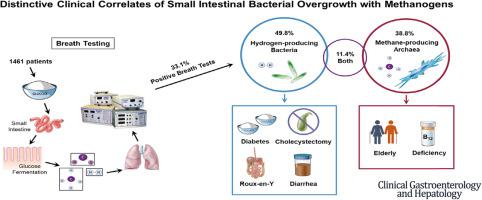Clinical Gastroenterology and Hepatology ( IF 11.6 ) Pub Date : 2021-09-29 , DOI: 10.1016/j.cgh.2021.09.035 Katelyn E Madigan 1 , Richa Bundy 1 , Richard B Weinberg 2

|
Background and Aims
Most patients with small intestinal bacterial overgrowth (SIBO) produce hydrogen by fermentation of dietary carbohydrates; however, ∼30% of patients with SIBO are colonized with Archaea, anaerobic organisms that produce methane. SIBO is associated with a plethora of symptoms and conditions, but their diagnostic significance is unclear. We aimed to determine if specific symptoms and conditions are associated with methanogenic SIBO.
Methods
This study received institutional review board approval (IRB00059873). In this retrospective cross-sectional study, we queried a database of glucose breath tests conducted for suspected SIBO at our tertiary care medical center, which included data on the presence or absence of gastrointestinal symptoms and conditions often associated with SIBO. All patients had undergone a standardized breath testing protocol.
Results
In a cohort of 1461 patients, 33.1% were SIBO positive; of these, 49.8% produced only hydrogen, 38.8% produced only methane, and 11.4% produced both gases. The following factors distinguished patients with hydrogen-producing SIBO, but not methanogenic SIBO, from SIBO-negative patients: vitamin B12 deficiency (odds ratio, 1.44; confidence interval [CI], 1.01–2.06; P = .046), Roux-en-Y gastric bypass (odds ratio, 2.14; CI, 1.09–4.18; P = .027), cholecystectomy (odds ratio, 1.42; CI, 1.06–1.91; P = .020), and diabetes (odds ratio, 1.59; CI, 1.13–2.24; P = .008). The absence of vitamin B12 deficiency was the sole discriminating factor between methanogenic and hydrogenic SIBO (odds ratio, 0.57; CI, 0.34–0.97; P = .038).
Conclusions
Patients with SIBO caused by methane-producing Archaea display a different spectrum of associated symptoms and clinical conditions compared with patients with SIBO caused by hydrogen-producing bacteria, particularly a lower incidence of vitamin B12 deficiency.
中文翻译:

小肠细菌过度生长与产甲烷菌的独特临床相关性
背景和目标
大多数小肠细菌过度生长(SIBO)患者通过膳食碳水化合物发酵产生氢气;然而,约 30% 的 SIBO 患者被古细菌定植,这种厌氧生物会产生甲烷。SIBO 与过多的症状和状况有关,但其诊断意义尚不清楚。我们旨在确定特定症状和状况是否与产甲烷 SIBO 相关。
方法
该研究获得了机构审查委员会的批准 (IRB00059873)。在这项回顾性横断面研究中,我们查询了在我们的三级医疗中心对疑似 SIBO 进行的葡萄糖呼气测试数据库,其中包括与 SIBO 相关的胃肠道症状和病症的存在与否数据。所有患者都接受了标准化的呼气测试方案。
结果
在 1461 名患者的队列中,33.1% 为 SIBO 阳性;其中,49.8% 只产生氢气,38.8% 只产生甲烷,11.4% 产生两种气体。以下因素将产氢 SIBO 患者与 SIBO 阴性患者区分开来:维生素 B 12缺乏症(优势比,1.44;置信区间 [CI],1.01-2.06;P = .046),Roux- en-Y 胃旁路术(优势比,2.14;CI,1.09–4.18;P = .027),胆囊切除术(优势比,1.42;CI,1.06–1.91;P = .020)和糖尿病(优势比,1.59; CI,1.13–2.24;P = .008)。缺乏维生素 B 12缺乏是产甲烷和氢 SIBO 之间的唯一区别因素(优势比,0.57;CI,0.34–0.97;P = .038)。
结论
与产氢细菌引起的 SIBO 患者相比,由产甲烷古细菌引起的 SIBO 患者表现出不同的相关症状和临床状况,特别是维生素 B 12缺乏症的发生率较低。











































 京公网安备 11010802027423号
京公网安备 11010802027423号